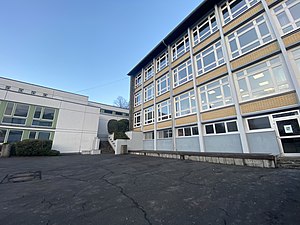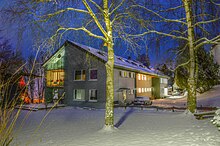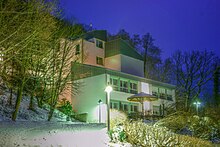Bodelschwingh-Gymnasium Herchen
| Bodelschwingh High School | |
|---|---|

|
|
| Old building and school yard of the BGH | |
| type of school | high school |
| School number | 167289 |
| founding | 1951 (Gymnasium) 1901 Original Realschule (no longer existent) |
| address |
Bodelschwinghstraße 2 |
| place | Windeck - Herchen |
| country | North Rhine-Westphalia |
| Country | Germany |
| Coordinates | 50 ° 46 '40 " N , 7 ° 30' 59" E |
| carrier | Evangelical Church in the Rhineland |
| student | about 780 |
| Teachers | 58 |
| management | Judith Pschibille, Ralf Dierenfeldt |
| Website | www.bgh-windeck.de |
The Bodelschwingh-Gymnasium (BGH) is a state-approved high school sponsored by the Evangelical Church of Rhineland in Windeck - Herchen , Rhein-Sieg-Kreis .
history
Beginnings
The original building was a sanatorium in Herchen, which was built at the end of the 19th century by a Dr. Wolfing was built from knowledge . In 1901 the Rector Otto Kühne bought it and set up a branch of the Evangelical Pedagogy he directed in Bad Godesberg , today's Otto Kühne School . It was a high school that was operated as a boarding school .
In the course of the next few years, further buildings were added to this so-called "upper house":
- "Fox hollows"
- "Swallow's nest"
- "Luginsland"
In 1921 a new school building with an auditorium was inaugurated and in 1924 the Hindenburg monument was erected , mainly by the students : an obelisk made of natural stone, which was placed on a wide platform above the Siegtal and its bronze plaque to the former students of the pedagogy who died in the First World War remembered. Today only the platform on the edge of the sports field remains. Other buildings in 1925 were “Haus Waldeck” and a gymnasium (which no longer existed when the Bodelschwingh grammar school was founded).
In addition, Reifershardt Castle and "Haus Siegblick" in Herchen were part of the pedagogy. A summer house of the rector was located in the 1920s where the refuge "Rector Kühne" stood until it was destroyed by fire on November 13, 2011.
In 1931 the pedagogy was closed due to the consequences of the global economic crisis .
Third Reich and post-war period
1934-35 one was in the buildings (Haus Waldeck) Country Year bearing the Hitler Youth furnished. From 1936 to 1939 the students from the German School in Barcelona who were evacuated during the Spanish Civil War were accommodated and taught here.
At the beginning of the Second World War , the site was used as a camp for the female labor service , and from 1943 to 1944 it was used as a children's camp . B. for the German secondary school Langemaß from Cologne-Mülheim . About 120 students were taught here, who also received a semi-military training. At the end of the war, a field hospital was set up on the site . As a flak position was also set up here , bombs were dropped, which in addition to the construction of the Hindenburg monument and the gymnasium also killed people.
After the evacuation by German troops, Belgian troops quartered here. After that, some of the buildings were used to accommodate displaced persons .
Bodelschwingh-Gymnasium Herchen
Today's Bodelschwingh-Gymnasium Herchen began under the sponsorship of the Protestant Rhenish Regional Church as a still nameless church boarding high school, which was supposed to offer young people, children of refugees and displaced persons who had come to the Rhineland a home and education after the Hitler era.
In 1950 “men came together in Herchen who had already helped Jewish members as Christians during the church struggle. Together with the church leadership of the Rhenish Church, they acquired the site in order to found a secondary school for (...) boys and girls ”. The result was a Protestant advanced high school , a type of school created after the First World War that followed the elementary school and led to the Abitur in six years .
"At the beginning of the school there is an assignment that understands education as pastoral care and pastoral care as education."
Lessons began with one class on April 9, 1951, under the direction of teacher Stöver. The boarding school was like a big family, as around three quarters of the students lived in the boarding school, and the teachers supervised and organized everyday boarding life in addition to the lessons. Large parts of the teaching staff came from what was then the GDR.
In 1957 a new school building was built for the growing school.
On May 11, 1962, director Karl-Heinz Stade took over the management of the school and boarding school. A new gymnasium was inaugurated in the same year. When another new school building was inaugurated in a new auditorium on December 14, 1973, the school was also given its current name, Bodelschwingh-Gymnasium Herchen . The students had already established a relationship with the Bethel diaconal institutions on regular days of reflection .
When at the beginning of the 1970s a three-tier school system, elementary school replaced, the Bodelschwingh-Gymnasium was one of CONSTRUCTION to a full high school , with lively inflow from the environment, so that the number of foreign students increased considerably.
On October 27, 1980, the new large gym and teaching swimming pool were ceremoniously opened.
Boarding school
The boarding school of the Bodelschwingh-Gymnasium Herchen was the origin and 'nucleus' of the BGH. Originally, the Evangelische Aufbaugymnasium was purely a boarding school. Only gradually did the school develop to its present size.
Many of the first boarding school students, who at the same time formed the majority of the total student body, were refugees from the area of the former GDR. The management of the boarding school was initially the responsibility of the school principals and the teaching staff also assumed the role of educators. However, the steady increase in the number of students made it increasingly difficult in the mid-1960s to do teaching and boarding school service in personal union, so that an organizational separation of school and boarding school became essential and full-time educators were hired. On July 2, 1965 Dieter Berg took over the boarding school management.
In 1969/1970, in addition to the existing boarding school buildings, four more houses with a cafeteria were built above the grammar school . Other new buildings were the houses of the teachers' housing estate in the valley view and a sports field.
In the years before its closure, the boarding school of Bodelschwingh-Gymnasium Herchen had around 68 places and consisted of five houses named after the five continents (Europe, America, Australia, Africa, Asia). The choice of names reflected the internationalization as part of the educational concept for the school as well as for the boarding school. A group of around 10 students from different countries lived in the boarding school and from there attended the Bodelschwingh-Gymnasium.
In addition to the internationality, the promotion of football was an important conceptual element of the boarding school. In cooperation with Germania Windeck and certified by the FVM, the boarding school offered girls and boys interested in football an extensive range of training and play opportunities.
The houses in the upper part of the boarding school offered space for up to 12 children and young people. One of the houses upstairs was a girls' house. In the lower area there was a bigger house with boys and girls. The independent group, which offered space for three young people, was located in a separate area.
In addition to the students, some of the house managers of the individual houses lived on the boarding school premises. They lived in official apartments that were integrated into the individual houses of the groups. The boarding school director also lived on the boarding school premises.
Despite the connection between high school and boarding school, not all boarding school students were high school students. There was close cooperation with the local secondary school, the secondary school as well as the Windeck comprehensive school founded in 2012 and the vocational college in Eitorf .
After the Evangelical Church in the Rhineland had decided to close for cost reasons, the boarding school of the Bodelschwingh-Gymnasium Herchen was closed at the end of the 2016/2017 school year on July 31, 2017.
International contacts
Since 1991 there has been a school partnership with the Presbyterian Secondary School (PHS) in Besongabang, in the tropical rainforest of Cameroon. Every two years, students and teachers from the Bodelschwingh-Gymnasium Herchen visit the PHS for a four-week encounter and work assignment, which has a lasting impact on the participants and is also supported by the school community, among other things in the form of fundraising campaigns. There was an incident here in 2014.
The Bodelschwingh-Gymnasium Herchen is the only German school to have an encounter program with Mongolian students that has existed since 2003. For four weeks a year, students from the Goethe School Ulan Bator visit the BGH and live with the families of their German guest students. Every two years during the summer holidays, they in turn have the opportunity to visit their Mongolian friends and get to know the country.
The cooperation with the “Collegio Valdese” or “Liceo linguistico Valdese” in Torre Pelice, a school belonging to the Waldensians, looks back on more than 30 years of tradition. Grade 10 pupils of the Bodelschwingh-Gymnasium Herchen spend about a week in Torre Pellice, where they get to know Italian life and especially the life of the Waldensians in their host families, in order to familiarize their Italian guest students with German culture during their return visit.
Since 2008, the BGH has had a school partnership with the French Collège Hector Berlioz in Communay (15 km south of Lyon), in which, in addition to improving foreign language skills, international encounters and getting to know French family and school life as well as the area around Lyon are part of Stand in the foreground.
Since 2013, the staff of the BGH has been enriched by one of 30 German teachers across Germany from the educational exchange service of the Conference of Ministers of Education (PAD).
Sports
Since 2010 there has been a cooperation with TSV Germania Windeck , which was certified in July 2011 by the Mittelrhein Football Association (FVM). As part of a dual training program, young people are given the opportunity to complete school and football training under one roof.
The school has very extensive sports facilities. These include a smaller gym and a large multi-sports hall. So it is possible that three classes can have physical education at the same time. The school also has its own swimming pool (17 meters, 3 lanes) and a sports field with an all-weather surface. There are four running tracks around the sports field, but the field is smaller than the standardized ones, so the length of a lap is only 300 meters (instead of 400 m).
The school regularly takes part in various (school sports) competitions, such as the district championships in football or volleyball as well as the Cologne Marathon , in which the school is represented every year with a girl and a boy relay.
Well-known former students
- Peter Stein , (Abitur: 1987), Member of the Bundestag and urban planner
- Volker Weininger (Abitur 1990), cabaret artist, author and handicraft speaker
- Annika Zeyen (Abitur 2004), wheelchair basketball player and gold medal winner at the Paralympics 2012
swell
- Anniversary publication 1951–1976
- Bodelschwingh-Gymnasium Herchen (Ed.): Annual rings. 50 years of Bodelschwingh-Gymnasium Herchen 1951–2001.
- Boarding school student at the Bodelschwingh-Gymnasium Herchen
- Notes by Hans Otto Weiper
Web links
Individual evidence
- ↑ a b Bernhard Harms: From the history of the Herchen “Pädaberges” before our school was founded. In: Bernhard Harms (Ed.): Bodelschwingh-Gymnasium Herchen 1951–1976. Anniversary commemorative publication. Herchen 1976, p. 9.
- ↑ Rector-Kühne Hut on November 13, 2011 (photo)
- ↑ Bernhard Harms: From the history of the Herchen “Pädaberges” before our school was founded. In: Bernhard Harms (Ed.): Bodelschwingh-Gymnasium Herchen 1951–1976. Anniversary commemorative publication. Herchen 1976, p. 12.
- ↑ Karl-Heinz Stade: 50 years of Bodelschwingh-Gymnasium Herchen. In: Bodelschwingh-Gymnasium Herchen (Hrsg.): Jahresringe. 50 years of Bodelschwingh-Gymnasium Herchen 1951–2001. P. 199.
- ^ Karl-Heinz Stade: The Evangelical Advanced High School in Herchen. A contribution to diakonia in the social life of our time. In: Festschrift for Edgar Boué. W. Crüwell Verlag, Dortmund undated, p. 229.
- ↑ Rudolf Heine: From the chronicle of our school. In: Bernhard Harms (Ed.): Bodelschwingh-Gymnasium Herchen 1951–1976. Anniversary commemorative publication. Herchen 1976, p. 15.
- ↑ a b Karl-Heinz Stade: 50 years of Bodelschwingh-Gymnasium Herchen. In: Bodelschwingh-Gymnasium Herchen (Hrsg.): Jahresringe. 50 years of Bodelschwingh-Gymnasium Herchen 1951–2001. P. 203.
- ↑ The boarding school of the Bodelschwingh-Gymnasium Herchen closes on July 31, 2017. At bgh-windeck.de, accessed on January 11, 2018
- ↑ http://www.general-anzeiger-bonn.de/region/sieg-und-rhein/mehr-sieg-und-rhein/Windecker-Sch%C3%BCler-in-Kamerun-%C3%BCberfallen-article1337662. html
- ↑ See http://www.bgh-windeck.de/index.php/home/schulleben/internationale-begegierungen
- ↑ http://www.ksta.de/region/rhein-sieg-bonn/rio-2016-diese-sportler-aus-rhein-sieg-starten-bei-den-paralympics-24705698








